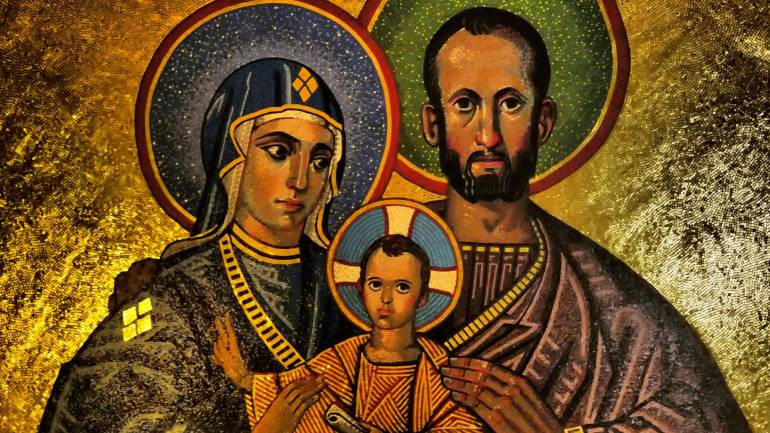Guiding Light of Unity: Celebrating the Holy Family

Today (December 31), the Mother Church joyfully celebrates the Feast of the Holy Family (Jesus, Mary and Joseph ), a special celebration nestled within the Christmas Octave. The Feast of the Holy Family is a profound and cherished moment within the holiday season, celebrated on the Sunday after Christmas.
When Christmas occurs on a Sunday, people celebrate it on December 30th instead. This commemoration stands as a beacon, illuminating the ideals of familial love, unity, and spiritual guidance within the framework of Jesus, Mary, and Joseph.
Originating in the 19th century in Canada, this celebration gained prominence through the endorsement of Pope Leo XIII. The celebration heralded the Holy Family as a timeless archetype, offering inspiration and guidance to families across cultures and epochs. Temporal fluctuations are present throughout this feast's journey. In 1911, Pope Pius X suppressed the feast, but it was fervently embraced and reintroduced into the Roman Missal in 1920.
Devotion to the Holy Family originates from the very cradle of Jesus' birth in Bethlehem. As shepherds converged to pay homage to the Child, their reverence naturally extended to His family, a gesture of collective honour. In a parallel act, the arrival of the wise men from the East mirrored this profound adoration by presenting gifts to the newborn King, symbolizing honor and respect for His family—an enduring narrative that resonates through the
observance of the Feast of the Holy Family.
St. John Chrysostom ardently advocated for every Christian household to evolve into a "family church," recognizing the transformative power of this integration on the very fabric of familial unity. But how does one manifest the essence of the Church within the family? The answer lies in centralizing Christ in both individual and familial life. This involves regular scriptural readings, daily prayers, collective attendance at Mass—particularly on Sundays and Holy Days of Obligation—emulation of the virtues of the Holy Family, and frequent participation in confession, all embraced as a united family unit.
By interweaving these practices into the fabric of family life, the family becomes a conduit for sanctification, echoing the divine teachings and grace of the Church. Hence, the Feast of the Holy Family isn't solely a tribute to the sacredness of Joseph, Mary, and Jesus. It stands as a call to infuse our family's existence with the essence of Christ's teachings, transforming our homes into havens of faith, love, and spiritual evolution.
The Second Vatican Council, drawing wisdom from the teachings of Church Fathers, illuminated the family as the "domestic Church." In the document Familiaris Consortio, Pope John Paul II articulates the family as a "Church in miniature" (ecclesia domestica), a concept that presents the family as a living embodiment and historical reflection of the Church's mystery (Familiaris Consortio, #49).
This profound recognition accentuates the identity of the family. It asserts that the family itself embodies a form of the Church through its unique way of life. Pope Paul VI, in his discourse on evangelization, asserted that the family encapsulates all the essential characteristics of the Church. Consequently, it becomes somewhat inaccurate for families to claim they "go to church," as they already constitute a Church within their own homes. Despite potential chaos, lack of structure, noise, or disarray, the essence remains—the home is a sanctuary of worship.
At its core, the Feast of the Holy Family encapsulates the essence of familial sanctity, presenting Jesus, Mary, and Joseph as paragons of virtue. The Feast of the Holy Family serves as a poignant reminder of how Jesus, Mary, and Joseph exemplified unconditional love, unwavering faith, and profound obedience to divine will, which form the bedrock of the Christian concept of family unity.
Joseph, portrayed as a righteous and caring father, embodies humility, strength, and steadfastness. Mary, revered for her unparalleled devotion and grace, epitomizes maternal love, faith, and unwavering commitment. Jesus, the center of this divine trinity, embodies obedience, wisdom, and compassion, nurturing an environment of love and spiritual growth within the family.
The feast's significance transcends historical narrative; it serves as a living testament, resonating with families navigating the complexities of contemporary life. It invites introspection into the virtues and dynamics of the Holy Family, offering invaluable lessons for modern households.
In an era where societal structures continually evolve, the Feast of the Holy Family remains profoundly relevant. It beckons families to anchor themselves in timeless values—love, faith, respect, and unity—characteristics that form the cornerstone of the Holy Family’s sanctity. This celebration becomes a compass guiding families amidst the ebb and flow of societal changes, fostering an environment where spirituality intertwines with everyday life.
Moreover, the Holy Family is a testament to the divine within the mundane. Despite living seemingly ordinary lives in Nazareth, they imbued their lives with extraordinary significance—an exemplary family life steeped in humility, love, and reverence for God. This feast amplifies the sacredness of everyday moments within the family unit, emphasizing the sanctity inherent in even the simplest of familial interactions.
As families today navigate the complexities of a rapidly changing world, the feast calls for reflection. It prompts households to emulate the virtues espoused by Joseph, Mary, and Jesus—a call to foster environments where love, respect, and spiritual growth flourish.
Ultimately, the Feast of the Holy Family catalyzes introspection, encouraging families to reevaluate their dynamics, prioritize shared values, and nurture spiritual growth. It stands not merely as a commemoration but as a guidepost, urging families to weave the virtues of the Holy Family into the fabric of their own lives.
Radio Veritas Asia (RVA), a media platform of the Catholic Church, aims to share Christ. RVA started in 1969 as a continental Catholic radio station to serve Asian countries in their respective local language, thus earning the tag “the Voice of Asian Christianity.” Responding to the emerging context, RVA embraced media platforms to connect with the global Asian audience via its 21 language websites and various social media platforms.














